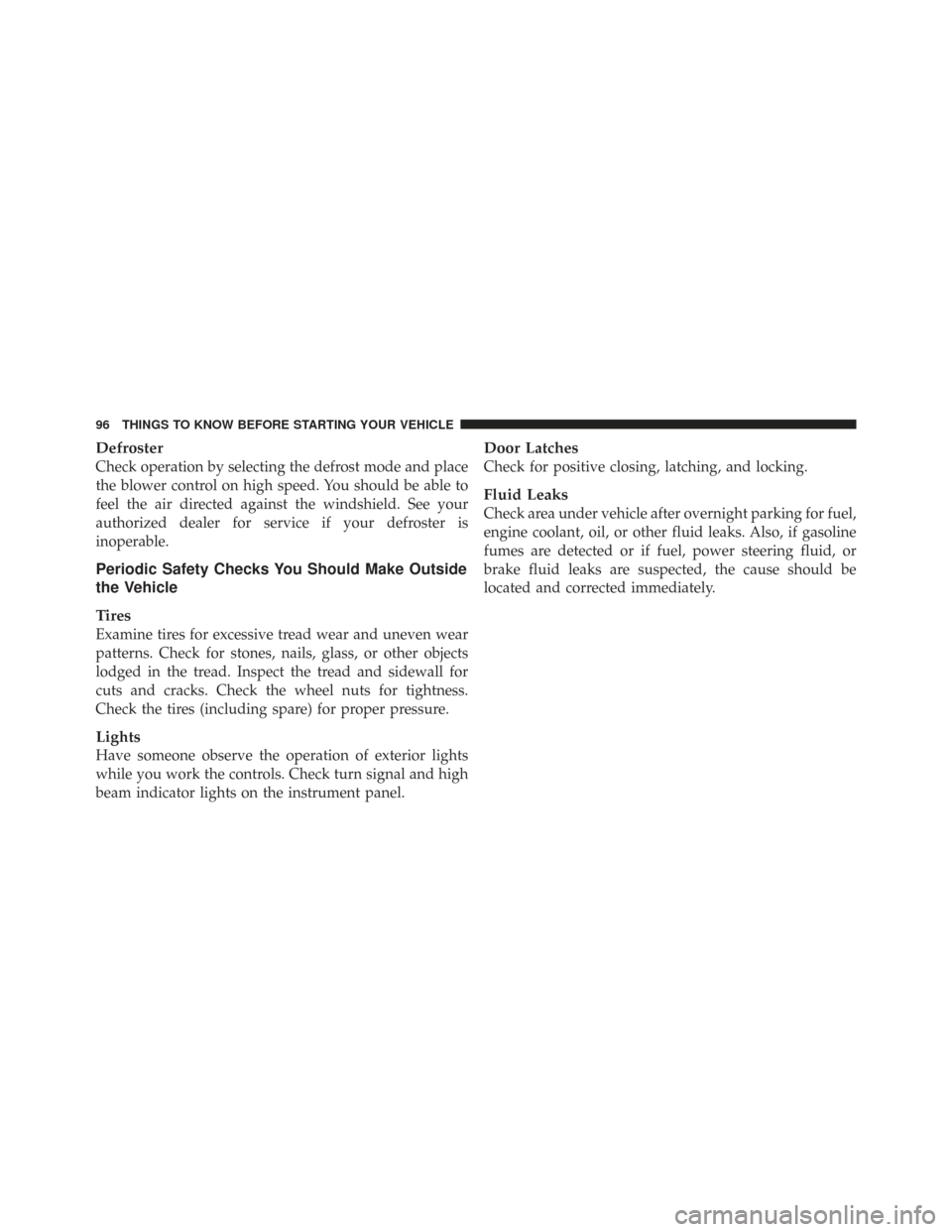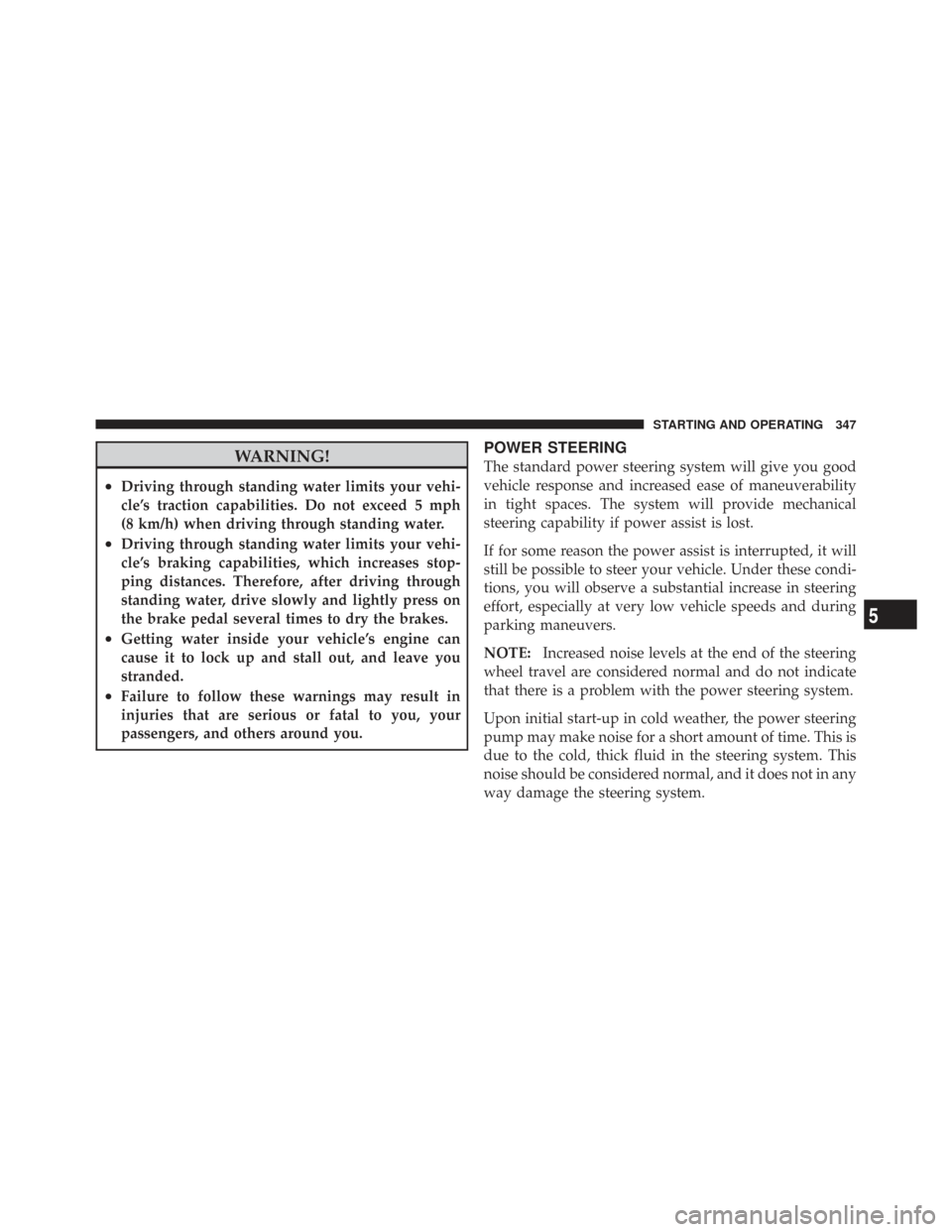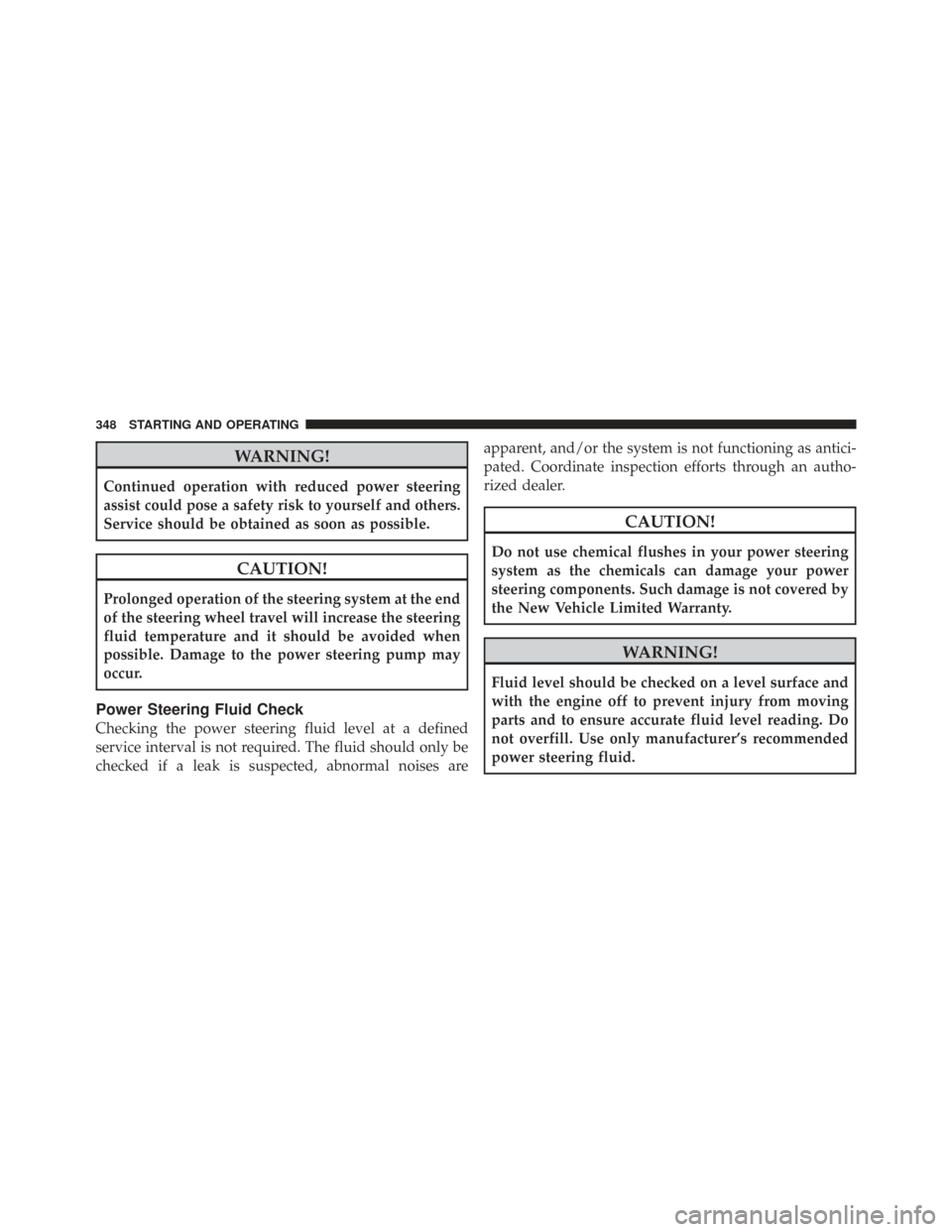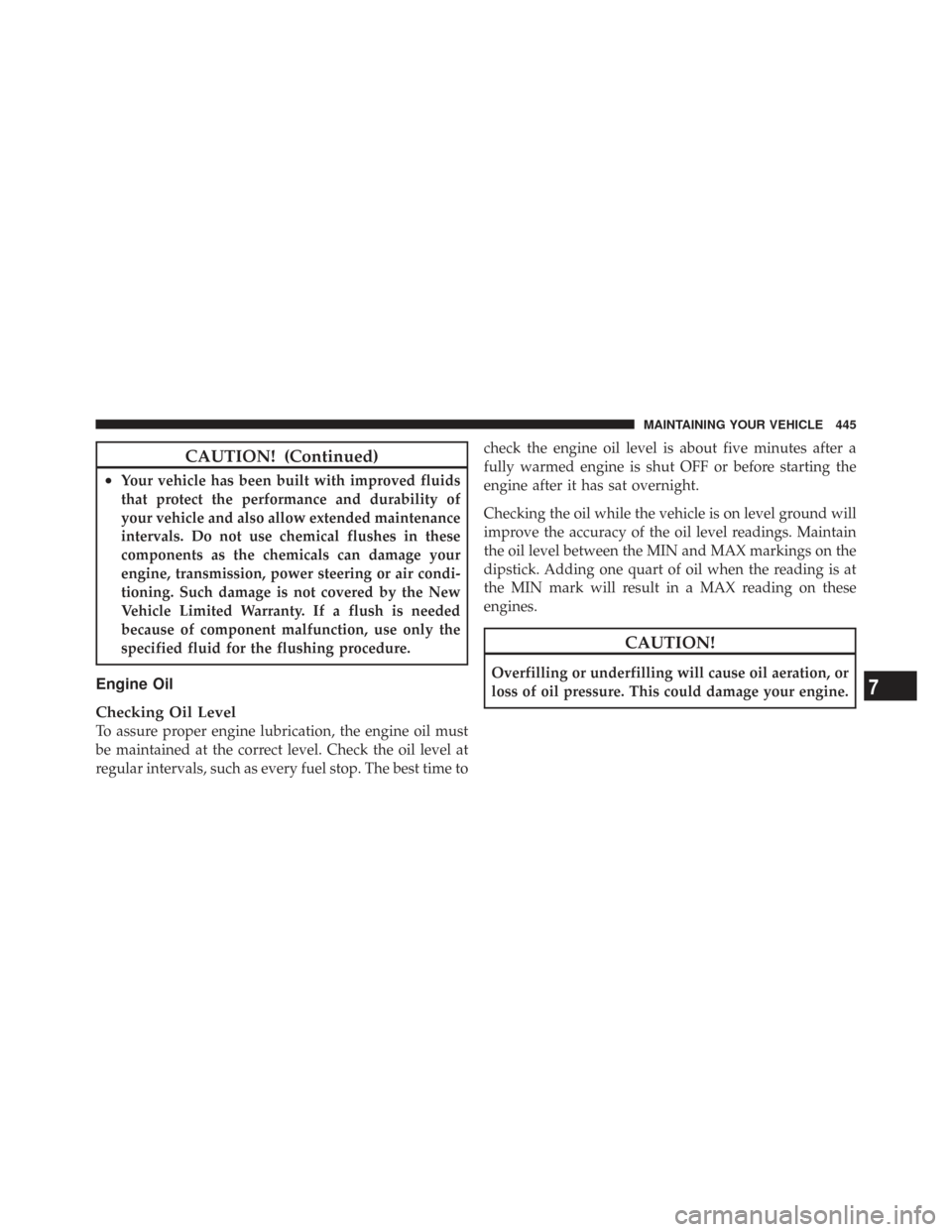Page 98 of 543

Defroster
Check operation by selecting the defrost mode and place
the blower control on high speed. You should be able to
feel the air directed against the windshield. See your
authorized dealer for service if your defroster is
inoperable.
Periodic Safety Checks You Should Make Outside
the Vehicle
Tires
Examine tires for excessive tread wear and uneven wear
patterns. Check for stones, nails, glass, or other objects
lodged in the tread. Inspect the tread and sidewall for
cuts and cracks. Check the wheel nuts for tightness.
Check the tires (including spare) for proper pressure.
Lights
Have someone observe the operation of exterior lights
while you work the controls. Check turn signal and high
beam indicator lights on the instrument panel.
Door Latches
Check for positive closing, latching, and locking.
Fluid Leaks
Check area under vehicle after overnight parking for fuel,
engine coolant, oil, or other fluid leaks. Also, if gasoline
fumes are detected or if fuel, power steering fluid, or
brake fluid leaks are suspected, the cause should be
located and corrected immediately.
96 THINGS TO KNOW BEFORE STARTING YOUR VEHICLE
Page 334 of 543

▫Shallow Standing Water .............. 345
� Power Steering ...................... 347
▫ Power Steering Fluid Check ........... 348
� Parking Brake ....................... 349
� Anti-Lock Brake System (ABS) ........... 350
▫ Anti-Lock Brake Warning Light ......... 352
� Electronic Brake Control System .......... 353
▫ Traction Control System (TCS) .......... 353
▫ Brake Assist System (BAS) ............. 354
▫ Electronic Stability Program (ESP) ....... 355
▫ ESP/BAS Warning Light .............. 356
� Tire Safety Information ................ 357
▫ Tire Markings ..................... 357 ▫
Tire Identification Number (TIN) ........ 361
▫ Tire Loading And Tire Pressure ......... 362
� Tires — General Information ............ 366
▫ Tire Pressure ...................... 366
� Tire Chains ......................... 373
� Snow Tires ......................... 375
� Tire Rotation ........................ 375
� Tire Pressure Monitor System (TPMS) ...... 376
▫ Base System ....................... 378
▫ Premium System — If Equipped ........ 380
� Fuel Requirements .................... 384
▫ 3.3L/3.8L Gasoline Engine ............. 384
▫ 4.0L Gasoline Engine ................ 385
332 STARTING AND OPERATING
Page 349 of 543

WARNING!
•Driving through standing water limits your vehi-
cle’s traction capabilities. Do not exceed 5 mph
(8 km/h) when driving through standing water.
•Driving through standing water limits your vehi-
cle’s braking capabilities, which increases stop-
ping distances. Therefore, after driving through
standing water, drive slowly and lightly press on
the brake pedal several times to dry the brakes.
•Getting water inside your vehicle’s engine can
cause it to lock up and stall out, and leave you
stranded.
•Failure to follow these warnings may result in
injuries that are serious or fatal to you, your
passengers, and others around you.
POWER STEERING
The standard power steering system will give you good
vehicle response and increased ease of maneuverability
in tight spaces. The system will provide mechanical
steering capability if power assist is lost.
If for some reason the power assist is interrupted, it will
still be possible to steer your vehicle. Under these condi-
tions, you will observe a substantial increase in steering
effort, especially at very low vehicle speeds and during
parking maneuvers.
NOTE:Increased noise levels at the end of the steering
wheel travel are considered normal and do not indicate
that there is a problem with the power steering system.
Upon initial start-up in cold weather, the power steering
pump may make noise for a short amount of time. This is
due to the cold, thick fluid in the steering system. This
noise should be considered normal, and it does not in any
way damage the steering system.
5
STARTING AND OPERATING 347
Page 350 of 543

WARNING!
Continued operation with reduced power steering
assist could pose a safety risk to yourself and others.
Service should be obtained as soon as possible.
CAUTION!
Prolonged operation of the steering system at the end
of the steering wheel travel will increase the steering
fluid temperature and it should be avoided when
possible. Damage to the power steering pump may
occur.
Power Steering Fluid Check
Checking the power steering fluid level at a defined
service interval is not required. The fluid should only be
checked if a leak is suspected, abnormal noises areapparent, and/or the system is not functioning as antici-
pated. Coordinate inspection efforts through an autho-
rized dealer.
CAUTION!
Do not use chemical flushes in your power steering
system as the chemicals can damage your power
steering components. Such damage is not covered by
the New Vehicle Limited Warranty.
WARNING!
Fluid level should be checked on a level surface and
with the engine off to prevent injury from moving
parts and to ensure accurate fluid level reading. Do
not overfill. Use only manufacturer’s recommended
power steering fluid.
348 STARTING AND OPERATING
Page 441 of 543
ENGINE COMPARTMENT — 3.3/3.8L
1 — Air Cleaner Filter7 — Engine Oil Fill
2 — Automatic Transmission Dipstick (3.3L Only) 8 — Engine Oil Dipstick
3 — Brake Fluid Reservoir 9 — Coolant Pressure Cap
4 — Battery 10 — Washer Fluid Reservoir
5 — Totally Integrated Power Module 11 — Power Steering Fluid Reservoir
6 — Engine Coolant Reservoir
7
MAINTAINING YOUR VEHICLE 439
Page 442 of 543
ENGINE COMPARTMENT — 4.0L
1 — Power Steering Fluid Reservoir7 — Engine Oil Dipstick
2 — Air Cleaner Filter 8 — Engine Oil Fill
3 — Brake Fluid Reservoir 9 — Coolant Pressure Cap
4 — Battery 10 — Washer Fluid Reservoir
5 — Totally Integrated Power Module
6 — Engine Coolant Reservoir
440 MAINTAINING YOUR VEHICLE
Page 447 of 543

CAUTION! (Continued)
•Your vehicle has been built with improved fluids
that protect the performance and durability of
your vehicle and also allow extended maintenance
intervals. Do not use chemical flushes in these
components as the chemicals can damage your
engine, transmission, power steering or air condi-
tioning. Such damage is not covered by the New
Vehicle Limited Warranty. If a flush is needed
because of component malfunction, use only the
specified fluid for the flushing procedure.
Engine Oil
Checking Oil Level
To assure proper engine lubrication, the engine oil must
be maintained at the correct level. Check the oil level at
regular intervals, such as every fuel stop. The best time tocheck the engine oil level is about five minutes after a
fully warmed engine is shut OFF or before starting the
engine after it has sat overnight.
Checking the oil while the vehicle is on level ground will
improve the accuracy of the oil level readings. Maintain
the oil level between the MIN and MAX markings on the
dipstick. Adding one quart of oil when the reading is at
the MIN mark will result in a MAX reading on these
engines.
CAUTION!
Overfilling or underfilling will cause oil aeration, or
loss of oil pressure. This could damage your engine.
7
MAINTAINING YOUR VEHICLE 445
Page 492 of 543
Chassis
ComponentFluid, Lubricant, or Genuine Part
Automatic Transaxle MOPAR�ATF+4 Automatic Transmission Fluid
Brake Master Cylinder MOPAR�
DOT 3 and SAE J1703 should be used or equivalent. If
DOT 3 brake fluid is not available, then DOT 4 is acceptable. Use
only recommended brake fluids.
Power Steering Reservoir MOPAR�
Power Steering Fluid +4, MOPAR� ATF+4 Automatic Trans-
mission Fluid
490 MAINTAINING YOUR VEHICLE